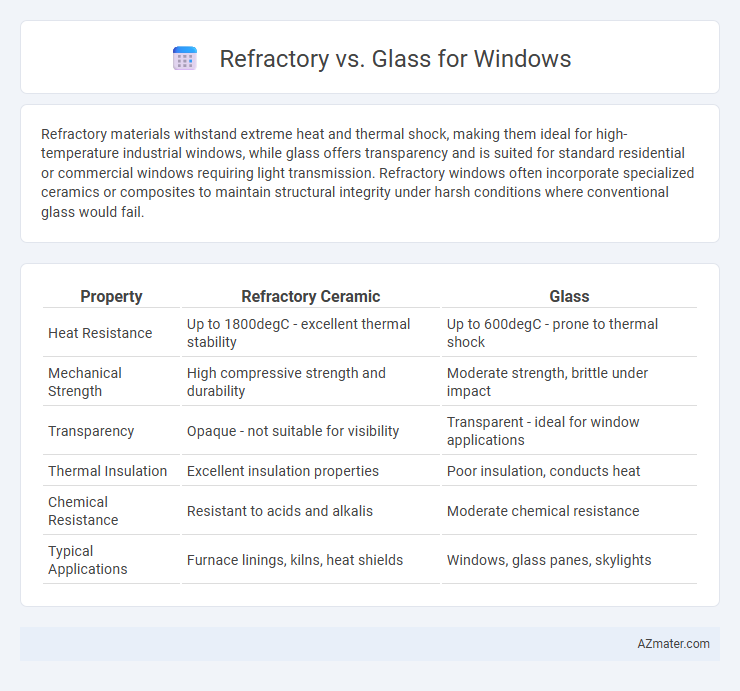Refractory materials withstand extreme heat and thermal shock, making them ideal for high-temperature industrial windows, while glass offers transparency and is suited for standard residential or commercial windows requiring light transmission. Refractory windows often incorporate specialized ceramics or composites to maintain structural integrity under harsh conditions where conventional glass would fail.
Table of Comparison
| Property | Refractory Ceramic | Glass |
|---|---|---|
| Heat Resistance | Up to 1800degC - excellent thermal stability | Up to 600degC - prone to thermal shock |
| Mechanical Strength | High compressive strength and durability | Moderate strength, brittle under impact |
| Transparency | Opaque - not suitable for visibility | Transparent - ideal for window applications |
| Thermal Insulation | Excellent insulation properties | Poor insulation, conducts heat |
| Chemical Resistance | Resistant to acids and alkalis | Moderate chemical resistance |
| Typical Applications | Furnace linings, kilns, heat shields | Windows, glass panes, skylights |
Introduction to Refractory and Glass Windows
Refractory windows are designed to withstand extreme heat and thermal shock, commonly used in industrial furnaces and high-temperature environments. Glass windows, typically made from materials like soda-lime or tempered glass, offer clarity and insulation for residential and commercial buildings. The choice between refractory and glass windows depends on the required thermal resistance, durability, and application-specific performance.
Key Differences Between Refractory and Glass
Refractory materials are heat-resistant and designed to withstand high temperatures without degrading, making them essential for applications exposed to intense heat such as furnace linings, while glass is primarily valued for its transparency, allowing light transmission and insulation in windows. Unlike glass, which can shatter under extreme thermal stress, refractory materials maintain structural integrity and thermal insulation at elevated temperatures. The key difference lies in functionality: refractory materials provide thermal resistance and durability in high-heat environments, whereas glass emphasizes visibility, weather resistance, and energy efficiency in architectural windows.
Material Composition and Properties
Refractory materials for windows typically consist of high-temperature resistant ceramics or fire-resistant composites, offering superior thermal stability and durability under extreme heat conditions. Glass windows are primarily made from silica-based compositions, providing transparency, weather resistance, and moderate heat resistance, but they lack the robustness required for high-temperature applications. The key difference lies in refractory materials' ability to withstand severe thermal stress without deformation, whereas glass excels in clarity and insulation but can shatter when exposed to rapid temperature changes.
Thermal Performance Comparison
Refractory materials provide superior thermal insulation in windows due to their high resistance to heat transfer and ability to withstand extreme temperatures, reducing energy loss significantly. Glass windows, especially those with low-emissivity coatings, offer moderate thermal performance but often allow higher heat conductivity compared to refractory counterparts. Choosing refractory frames or incorporating advanced insulation technologies in glass can optimize energy efficiency by minimizing heat gain or loss in various climates.
Durability and Lifespan Analysis
Refractory materials used in window construction exhibit superior durability compared to traditional glass, with resistance to high temperatures and thermal shock significantly extending their lifespan. Glass windows, while offering clarity and aesthetic appeal, tend to be more susceptible to cracking and degradation under extreme environmental conditions. Lifespan analysis reveals that refractory windows can last several decades with minimal maintenance, whereas standard glass typically requires replacement or repairs within 10 to 20 years depending on exposure.
Safety and Fire Resistance Factors
Refractory materials for windows offer superior fire resistance compared to glass, withstanding temperatures exceeding 1,000degC without losing integrity, which significantly enhances building safety during fires. Glass window options, especially tempered or laminated fire-rated glass, provide limited fire resistance by delaying heat transfer and maintaining structural stability under lower temperature ranges, generally up to 600degC. Choosing refractory window components ensures maximum protection against fire hazards, while fire-rated glass balances visibility and safety in fire-prone environments.
Energy Efficiency: Which Performs Better?
Refractory materials offer superior thermal resistance and insulation, minimizing heat transfer and maintaining indoor temperature more effectively than glass. Glass windows often require double or triple glazing with low-emissivity coatings to enhance energy efficiency, whereas refractory windows inherently reduce energy loss due to their high heat tolerance. Choosing refractory over traditional glass can lead to significant energy savings and improved climate control in buildings.
Aesthetic and Design Considerations
Refractory materials offer a robust, industrial aesthetic with textured, matte finishes that enhance architectural features through durability and heat resistance, ideal for modern or minimalist designs. Glass provides versatility in visual appeal with options like clear, tinted, frosted, or patterned finishes, facilitating natural light infusion and creating openness in spaces. The choice between refractory and glass hinges on balancing the desired aesthetic impact with functional design goals, such as transparency, insulation, and surface texture.
Cost Comparison: Refractory vs Glass
Refractory materials for windows often involve higher initial costs due to specialized installation and durability features, while glass options generally offer a more budget-friendly upfront price. Over time, refractory materials can prove cost-effective by reducing maintenance and replacement expenses in harsh environments. Glass windows typically require more frequent upkeep and may lead to higher long-term costs depending on exposure and usage conditions.
Best Applications for Each Material
Refractory materials excel in high-temperature environments, making them ideal for industrial windows in furnaces and kilns where thermal resistance and durability are critical. Glass windows offer superior clarity and are best suited for residential and commercial buildings, providing natural light and aesthetic appeal while maintaining adequate insulation. For applications requiring both heat resistance and visibility, specialized refractory glass or ceramic glass combines the strengths of both materials effectively.

Infographic: Refractory vs Glass for Window
 azmater.com
azmater.com